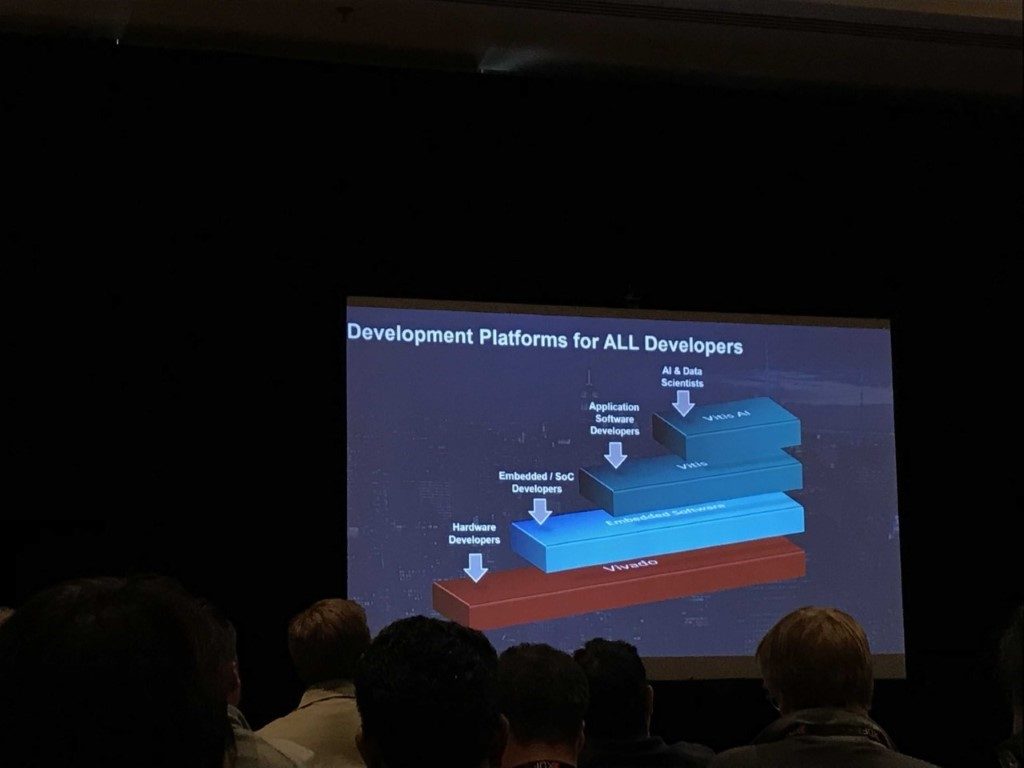What do cancer research, finance, genome sequencing, driverless cars, and outer space have in common? Aside from all being fascinating applications, each of them are progressing through the use of FPGA technology! To infinity and beyond, right? October’s Xilinx Developer Forum in San Jose was a great reminder of just how compelling and avante-garde an industry we are in. Sometimes the FPGA market can feel niche and small – even living in a technology hub like Seattle and having frequent conversations with other techies and engineers, it isn’t uncommon to encounter puzzled looks when I bring FPGA into the conversation. And, to this point, the central theme of XDF was that it’s OK that not everyone is familiar with FPGAs – they shouldn’t have to be.
This illustrates the main point of Vitis, Xilinx’s new Unified Software Platform unveiled at XDF. According to Xilinx CEO Victor Peng’s keynote at the conference, adaptive computing is only gaining momentum across all markets. And in order to serve the growing markets for adaptive computing, Xilinx must make their tools increasingly appealing to software engineers and scientists, not just RTL engineers. In the age of machine learning, machine vision, 5G and AI, and other big data operations, the pool of application software developers and data scientists is much deeper than that of hardware engineers – and it’s growing faster. Xilinx is focused on evolving their tools so that these folks focused on the “softer side of design” can benefit from the power and flexibility of FPGA acceleration without even needing to know “how to spell FPGA,” which was a popular saying throughout the conference.

This pyramid represents the relative effort Xilinx has put in to date on the different elements of the company’s tools. The reality is that the people available with the required skill sets for each element would look inversely proportionate, meaning that there is A LOT of untapped potential.
Vitis is a compilation of existing Xilinx tools into a single environment. While the tools may look the same, bringing all Xilinx devices under a single design environment should improve ease of use, development flow, and validation. This defines the core of Vitis’ value – enhanced productivity. With it, application developers can continue to innovate on algorithm design and leverage compute acceleration without waiting for the prohibitively long design cycle of custom ASICs.

Xilinx Unified Software Platform is a repackaging of existing Xilinx tools.
While the functionality might not be inherently different, the emphasis on open-source is a definite demarcator. Vitis is “free and open-source,” and according to Peng, this marks a new era of software developer focus at Xilinx. This begs the question, though: what does free and open-source actually mean? Vitis will be completely free and available for download without barrier, but in order to program Xilinx hardware, Vivado and a Vivado license will still be required. Vitis can be installed without Vivado for software development, but the hardware acceleration function will be lost. Great pains were taken to ensure that development on Vivado will not cease.
So, what all will the Vitis download include?
- Vitis target platform
- Shell-based development architecture “surrounding” the hardware and software kernels
- Xilinx Runtime (XRT) abstracts common data tasks
- Domain specific wrappers
- Compilers, analyzers, and debuggers
- DevOps environment integration
- Standalone analysis tool, the “Vitis Analyzer”, for analyzing accelerator performance
- A vast collection of modifiable, best-in-class libraries designed to be used in final implementation (available on GitHub)
When is it coming out?
Vitis and all documentation will be available in November. If you want to get an overview of Vitis from Xilinx go to https://www.xilinx.com/products/design-tools/vitis.html. To start digging into the nitty gritty, visit https://developer.xilinx.com/, the new Xilinx developer site and navigate to the “documentation” tab.


it’s horrible, confusing, full of UI crud and windows that hang. what a mess.
Hey thanks for the comment. We definitely want to know what the actual user experience is so far versus the vision that is being put forward. Are you a long time Vivado user?
In a fast moving industry, there are some diehards die-heads among us who try as hard as possible to ignore any article without a conspicuous date stamp on top. This one is a rare date-bereft article that was actually informative enough that I don’t regret dispensing with my usual cruft filter policy. Nicely done.
The software upgrade I’m waiting for is Zuck 2.0: move fast and date things. Publication dates: what they used to teach in frosh week as a prerequisite for Freshhuman 101. For the record, Google search reports from its magic crystal ball that the original publication date of this article was 18 October 2019.
Too bad the previous commentator didn’t return to document his distance in more specific terms.
s/diehards/diehard, s/distance/distaste in my previous comment. Postprandial keyboard haze.